The Taieri River
The Taieri River is an important geographic, economic, and environmental feature of east Otago. The river corridor has been an important pathway for access to central Otago since the early days of human settlement. A small gorge near the sea is tidal almost as far upstream as Dunedin Airport on the Taieri Plain. Upstream of the Taieri Plain, a long gorge is followed by the old Otago Central railway to Middlemarch. The railway is now used only for tourist traffic. The railway line now ends at Middlemarch and the Otago Central Rail Trail continues as a walking, biking and horse-riding track past Ranfurly, and ends in Clyde on the Clutha River (see map).
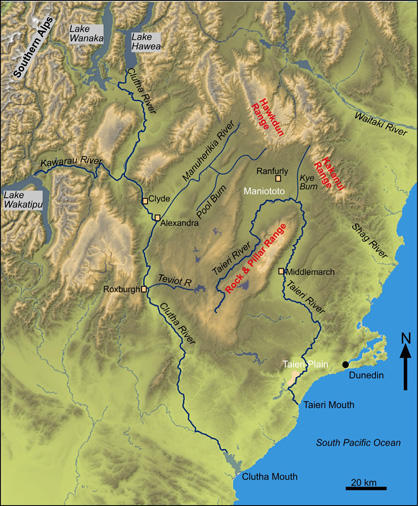
Topographic map of east and central Otago, showing the contrasting courses of the >200 km long Clutha and the Taieri Rivers. The Clutha River flows right across Otago from the Southern Alps to the sea, whereas the Taieri River follows a circuitous course in east Otago.
The Taieri River is the second-largest river that drains the Otago landscape, and it is almost as long as the largest one, the neighbouring Clutha River. Both these rivers are more than 200 km long. The Clutha flows from the western mountains, the Southern Alps, right across Otago, to the sea on the east coast. In contrast, the Taieri River drains only the eastern Otago uplands, and follows an almost circular path from its source to the sea. The Taieri River discharges to the Pacific Ocean at Taieri Mouth, only 60 km from its source area in the Lammermoor and Lammerlaw Ranges (see maps). From its source, the Taieri River flows almost entirely around the Rock & Pillar Range, and the middle reaches of the river are only 30 km from the source. Deep Stream, a major tributary to the middle reaches of the Taieri River has its source in the same area of the Lammermoor and Lammerlaw Ranges.
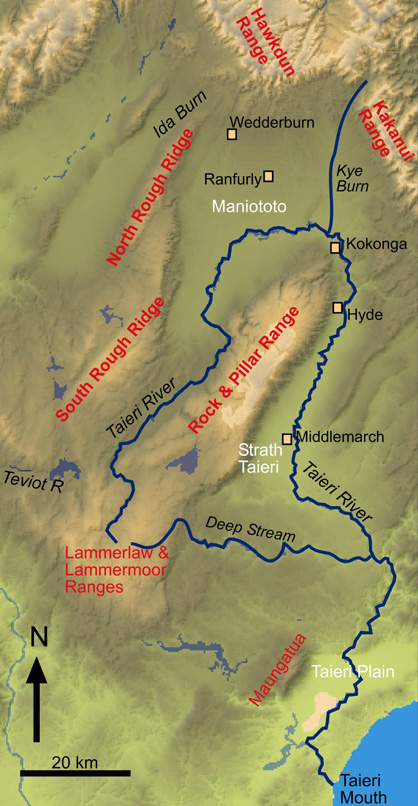
Topographic map of the Taieri River catchment in east Otago. The Otago Central Rail Trail starts at Middlemarch in the Strath Taieri basin. The trail passes high above a gorge in the Taieri River between Hyde and Kokonga, then goes to Ranfurly in the Maniototo basin. The rail trail leaves the Taieri catchment near Wedderburn, where it crosses a low pass to the Ida Burn in the Clutha River catchment.
The view from Middlemarch
Middlemarch lies beside the Taieri River in the Strath Taieri basin. This inland basin has been formed by folding of the schist bedrock. To the west, the Rock & Pillar Range (Patearoa Gold) is an upfolded ridge (antiform) that is still slowly increasing in height and length at about 0.1 millimetres/year. This deformation of the bedrock and the low relief surface (Waipounamu Erosion Surface) has been going on for about 1 million years. An active fault at the eastern foot of this range is facilitating this on-going rock deformation. To the east of the basin, several similar but lower folded ridges are forming, each with a small active fault on its eastern margin. The Strath Taieri basin itself has been formed as a down-folded zone (synform) between the flanking ridges. Despite the down-folded nature of the basin, the floor of the basin is actually rising slowly too, but at a much slower rate than the flanking ridges. As a result of this general tectonic uplift of the area, the Taieri River has cut into schist bedrock for most of its length in the Strath Taieri area. Thin veneers of gravel rest on the bedrock in places, but the schist floor is never far away. Schist outcrops (tors), dominate the landscape on most slopes.
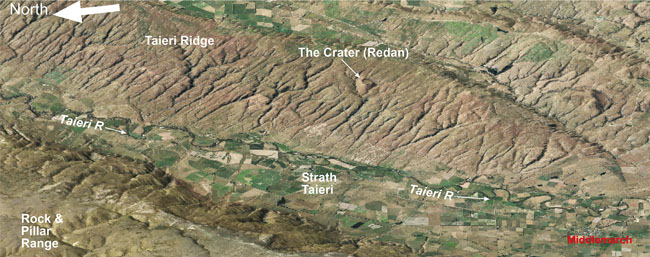
Oblique view of the Strath Taieri basin and Middlemarch township, between two actively rising schist ridges: Rock & Pillar Range and Taieri Ridge. The Otago Central Rail Trail runs parallel to the Taieri River on the western side of the valley, northwards from Middlemarch. The Crater (also called Redan) on Taieri Ridge was formed by an explosive volcanic eruption 25 million years ago, when the land was near to sea level. The crater rim is defined by fragmental schist and volcanic material blown out of the eruption cavity.
Farther up the valley near Hyde, the schist basement is covered with some 40 million year old sediments and capped with basalt lavas from 20 million year old volcanoes. These sediments and volcanic rocks, which are up to 100 m thick, have been folded and faulted with the underlying schist basement. The combination of hard volcanic rocks and schist basement in this area has forced the Taieri River to cut a narrow gorge into the upstream end of the Strath Taieri basin.
The view from Ranfurly
Ranfurly lies on a large inland plain, the Maniototo basin, which is a similar down-folded basin to Strath Taieri, but broader and more geometrically complex. River gravels have been accumulating in parts of the basin for more than two million years. These gravels were derived from the mountains to the north: the Kakanui and Hawkdun Ranges (see maps above). The principal river draining these mountains is now called the Kye Burn, and its present and ancestral course has always been towards the south from these ranges. Smaller but parallel rivers have shed gravel southwards into the basin as well.
The upper reaches of the Taieri River flow towards the north from their source in the Lammermoor and Lammerlaw Ranges, and meet the Kye Burn and associated rivers within the Maniototo basin. However, these upper reaches of the Taieri River have been more tectonically active, with more uplift and erosion, so none of the ancient river river gravels have been preserved in this area. The upper Taieri valley is a down-folded area between two up-folded ridges: the Rock & Pillar Range (Patearoa Gold) to east and South Rough Ridge to the west, and these ridges have been forming slowly over the past million years. Like the Strath Taieri basin, the down-folded valley is rising tectonically, but at a slower rate than the flanking ridges. The Taieri River is being forced to cut down into parts of this rising valley, forming some gorged sections.
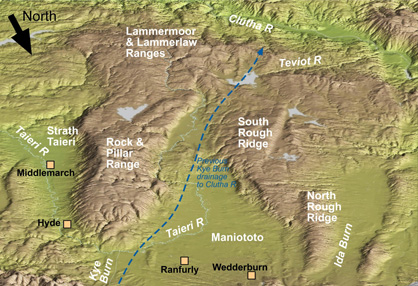
Oblique topographic view (2x vertical exaggeration) of the upper Taieri River catchment. The view is towards the southwest, as seen from above Ranfurly. The Maniototo basin in centre forground is where the Kye Burn and other streams from the north join the Taieri River that drains from the south. The Taieri River then bends almost 180 degrees and passes through a gorge it has cut in volcanic rocks and schist bedrock, to Hyde and the Strath Taieri basin. Blue dashed line shows the ancestral path of the Kye Burn to the Clutha catchment.
Changed flow direction of the upper Taieri River
The folded ridges and valley that now control the course of the upper Taieri River have been forming for about 1 million years. Before that time, and until about half a million years ago, the area was a broad gravel-covered river plain with rivers flowing south from the Kakanui and Hawkdun Ranges to what is now the Clutha River. The principal river on this plain at that time was the Kye Burn. The Taieri River headwaters at that time were in the area of what is now the Strath Taieri basin. There was a rocky barrier, partly defined and controlled by the basalt lava near Hyde, between the ancestral Kye Burn in the Maniototo area, and the ancestral Taieri River in the Strath Taieri area. The ancestral Kye Burn's southward flow was eventually blocked about half a million years ago by the continued rise of the Lammermoor and Lammerlaw Ranges. This forced part of the river system to reverse its flow direction and head northwards. At the same time, the volcanic rock barrier between Maniototo and Strath Taieri basins was breached, and the ancestral Taieri River course suddenly became much longer, and also circuitous around the rising Rock & Pillar Range (see cartoon below).
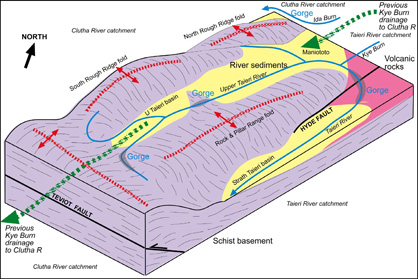
Three-dimensional cartoon of the structure of the upper Taieri catchment, showing the present circuitous river course, and the past drainage of the Kye Burn to the Clutha River (green arrows). Red dashed lines and arrows depict up-folded ridges that interrupted the flow of the ancestral Kye Burn over the past million years.
Evidence for the ancient Kye Burn flow to the Clutha River
1. Remnants of Kye Burn pebbles in the Clutha catchment
Much of the geological evidence for the change in flow direction of what is now the upper Taieri River has been removed by erosion. In particular, the ancient Kye Burn river gravels that must have been present between the Maniototo basin and the Clutha River have long since been removed by erosion. These river gravels, as preserved upstream of Ranfurly, are distinctive in that they consist of greywacke debris, rather than schist. This is because their source areas, the older Kakanui and Hawkdun Ranges to the north, consist of greywacke bedrock rather than the schist that dominates most of the Taieri catchment. Significantly, some distinctive rocks that occur within these greywacke ranges have been found in the Clutha catchment along the path of the ancestral Kye Burn. In particular, hard conglomerate and quartz-rich pebbles are preserved within the schist-rich younger sediments. These distinctive and rare pebbles have survived the erosion of the older gravels.
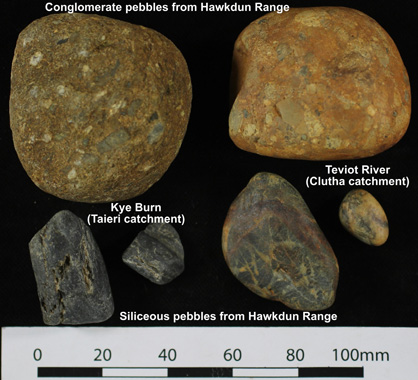
Distinctive pebbles derived from the greywacke bedrock of the Hawkdun Range on the north side of the Maniototo basin. The pebbles on the left of the image were collected from the modern Kye Burn at the base of the Hawkdun Range, in the modern Taieri River catchment. The pebbles on the right were collected from the headwaters of the Teviot River in the Clutha catchment, along the course of the ancient Kye Burn when it flowed southwards through what is now the upper Taieri valley.
2. Ancient Taieri River gravels derived from schist bedrock, with no greywacke
The ancestral Taieri River had its headwaters in the Strath Taieri area, which has schist bedrock throughout. Gravel deposits from the ancestral Taieri River are rare, as the on-going uplift has caused nearly all such deposits to be eroded. However, there are some small gravel deposits preserved high above the river at the southern end of the Strath Taieri basin. These gravel deposits were mined historically for alluvial gold. The gravels are made up entirely of pebbles derived from local schist bedrock, with no greywacke pebbles. The exact age of the older gravels is not known, but they are more than half a million years old. At that time, no drainage was occurring between the Maniototo basin and the Strath Taieri basin. In contrast, the modern Taieri River at the same place contains abundant greywacke pebbles that are being introduced by the Kye Burn near Kokonga.
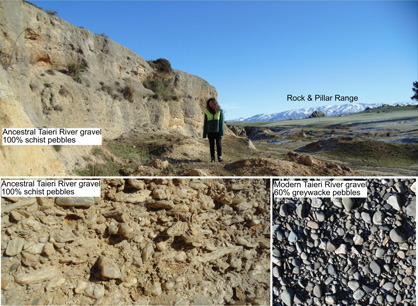
Photographs of gravels deposited by the ancestral Taieri River at the southern end of what is now the Strath Taieri basin. These gravels occur high above the modern river, and the outcrops were made by historic gold miners. The old gravels contain only schist debris from the nearby bedrock, with no greywacke from the Maniototo basin. The modern Taieri River bed below these ancient deposits has abundant greywacke pebbles.
3. Isolation and evolution of freshwater fish populations
Additional evidence for the changes in river drainage comes from the freshwater fish species in the modern rivers. These native galaxiid fish are limited to freshwater streams and do not go to sea at all in their life cycles. Genetic analysis of the DNA in these fish show that species in different catchments are closely related genetically, and once were in reproductive continuity. Their common ancestors were a widespread and distinctive fish species called “flathead” galaxiids. Rise of the fold mountains over the past million years has separated populations of this ancestral species, and several new species have evolved separately since then, in the modern river systems (see cartoon below). Flathead galaxiids in what was the Kye Burn flowing into the Clutha River have evolved into separate species: G. depressiceps in the upper Taieri catchment, and G. 'teviot' in the upper reaches of the Teviot River. The population of G. 'teviot' occurs along the course of the ancient Kye Burn, in the same location as the river-transported pebbles derived from the Hawkdun Range.
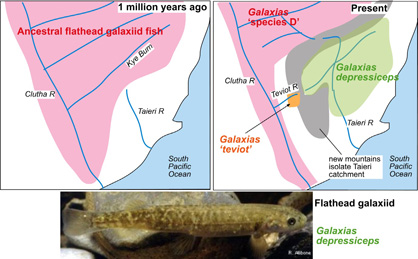
Development of some different species of native freshwater galaxiid fish in east and central Otago. A million years ago, the ancestral flathead galaxiids were widely distributed in the ancient Clutha catchment (pink area in left panel) that included the Kye Burn. This species did not occur in what was a smaller ancestral Taieri River. Rise of folded ridges (grey in right panel) caused formation of the modern, longer, Taieri River and a separate flathead galaxiid species, G. depressiceps, has developed in what is now upper Taieri and Maniototo, extending into Strath Taieri. An isolated population of flathead galaxiids in the headwaters of the Teviot River is closely related to G. depressiceps, and has developed into a new species, G. 'teviot' since the Kye Burn ceased to flow to the Clutha River and became the upper Taieri River. Photograph of G. depressiceps is by Richard Allibone, from NIWA Atlas of NZ Freshwater Fishes
Summary of the long-term evolution of the Taieri River catchment
Ten million years ago, the Taieri River was a short drainage system that drained coastal hills. These hills were formed by some uplift of schist bedrock along faults and addition of volcanic cones, particularly around what is now Dunedin city. The ancestral Taieri River gravels contained pebbles of schist and volcanic rocks, and no greywacke. Central Otago was occupied by a large lake, Lake Manuherikia, which was partly dammed by the coastal hills.
When the Kakanui and Hawkdun Ranges began to rise 5 to 8 million years ago, these greywacke ranges shed large volumes of river gravel southwards into the lake. The lake was filled in with these gravel deposits by 2 million years ago, resulting in a broad river plain from the greywacke ranges to the ancestral Clutha River. Rise of the folded ranges over the past million years has disrupted this river plain and formed a more complex landscape. The drainage divide between the Maniototo basin and the basins to the west began to form at this time, as the folds of North and South Ridges rose as a long and complex ridge.
The south-flowing Kye Burn was reversed by rise of the combination of Rock & Pillar Range, Lammermoor and Lammerlaw Ranges, and South Rough Ridge. This initially led to formation of a lake in what is now the upper Taieri valley and Maniototo basin. Water from that lake spilled over the volcanic ridge near Kokonga to the Strath Taieri basin, causing the initial down-cutting of what is now a gorge. These processes linked the various segments of the drainage system to form the longer and circuitous modern Taieri River. Greywacke pebbles from the Hawkdun and Kakanui Ranges began to make their way down the Taieri River less than half a million years ago, and they now make up between 30 and 50% of the Taieri River gravels between Kokonga and the Taieri Plain.
The changes in topography resulted in fish speciation, as in the diagrams above. However, the flathead galaxiid species in the upper Taieri catchment, G. depressiceps, that evolved from ancestral flatheads of the Clutha catchment, has not spread beyond the Strath Taieri basin into the lower Taieri River, despite the present water connections. Instead, the lower Taieri River is still occupied by older galaxiid species including G. eldoni that evolved in the long-lived coastal hills. Hence, some of the best records of the evolution of the landscape of the Taieri River catchment have been preserved in the DNA of the freshwater galaxiid fish species.
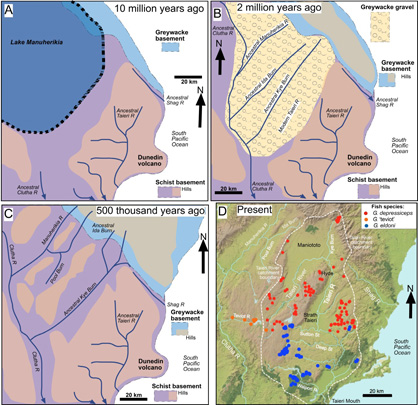
Maps showing the evolution of the Taieri River catchment, and adjacent catchments, over the past 10 million years. Coastal areas had minor relief 10 million years ago that was augmented by volcanism, and the ancestral Taieri River was controlled by that relief. The central Otago area was occupied by a large freshwater lake at that time, and the lake was progressively filled in by river gravels as the Hawkdun and Kakanui Ranges rose to the north. In this context, the modern circuitous Taieri River course is a relatively young phenomenon (last 0.5 million years). Current distributions of freshwater galaxiid fish species that have evolved with the evolving Taieri River landscape are shown in the fourth panel.
Additional information
- Craw D 2013. River drainage reorientation during placer gold accumulation, southern New Zealand. Mineralium Deposita 48: 841–860.
- Craw D, Upton P, Walcott R, Burridge C, Waters J 2012. Tectonic controls on the evolution of the Clutha River catchment, New Zealand. New Zealand Journal of Geology and Geophysics 55, 345-359.
- Craw, D, Craw L, Burridge C, Wallis G, Waters J 2016. Evolution of the Taieri River catchment, East Otago, New Zealand. New Zealand Journal of Geology and Geophysics vol 59
- Craw, D., Upton P, Burridge C, Wallis G, Waters J 2016. Rapid biological speciation driven by tectonic evolution in New Zealand. Nature Geoscience 9: 140-144.
- Waters JM, Burridge C, Wallis G, Craw D 2015. Geology shapes biogeography: Quaternary river-capture explains New Zealand's biologically 'composite' Taieri River. Quaternary Science Reviews 120: 47-56.
Related
- Using river vicariance to pinpoint the pace of molecular change
- River capture: South Island, New Zealand
- The circuitous path of the Taieri River in east Otago
- Sutton Salt Lake, Otago
- Evaporative salts in Central Otago